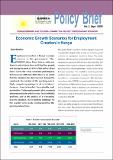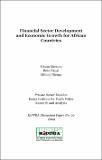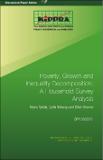Discussion Paper No. 87 of 2008 on Growth and Distribution of Factor Incomes in Kenya: A Social Accounting Matrix Perspective
| dc.date.accessioned | 2021-03-31T08:43:30Z | |
| dc.date.available | 2021-03-31T08:43:30Z | |
| dc.date.issued | 2008 | |
| dc.identifier.uri | http://repository.kippra.or.ke/handle/123456789/2781 | |
| dc.description.abstract | Economic growth and income distribution are two issues that are currently dominating policy decisions of both developed and developing countries. Governments across the globe are struggling to find an economic solution that ensures both GDP growth and a fair distribution of incomes for members of society to help improve living standards for low income earners. This paper specifically highlights Kenya's existing and previous growth strategy, and how it has affected the distribution of income in the economy. More specifically, it uses a Social Accounting Matrix methodology to simulate the distribution of factor incomes based on the economy's GDP growth focusing on different sectors. Through simulation of three different growth strategies, this paper recommends a development strategy for Kenya that ensures the most equitable distribution of factor incomes in the economy. | en |
| dc.language.iso | en | en |
| dc.publisher | The Kenya Institute for Public Policy Research and Analysis | en |
| dc.relation.ispartofseries | DP/87/2008; | |
| dc.subject | Economic growth | en |
| dc.subject | Social accounting matrix | en |
| dc.subject | Income distribution | en |
| dc.subject | Growth simulations | en |
| dc.subject | Growth strategy | en |
| dc.title | Discussion Paper No. 87 of 2008 on Growth and Distribution of Factor Incomes in Kenya: A Social Accounting Matrix Perspective | en |
| dc.type | KIPPRA Publications | en |
| ppr.contributor.author | Mwendwa, Mwende |
Files in this item
This item appears in the following Collection(s)
-
Discussion Papers [326]




